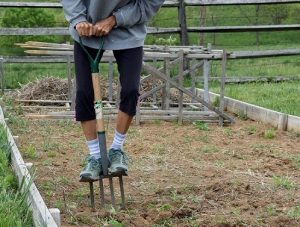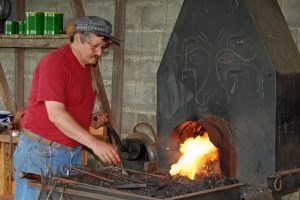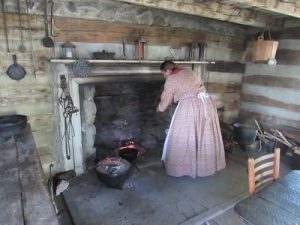Local News
101 Year Legacy: Seeking Equality & Justice
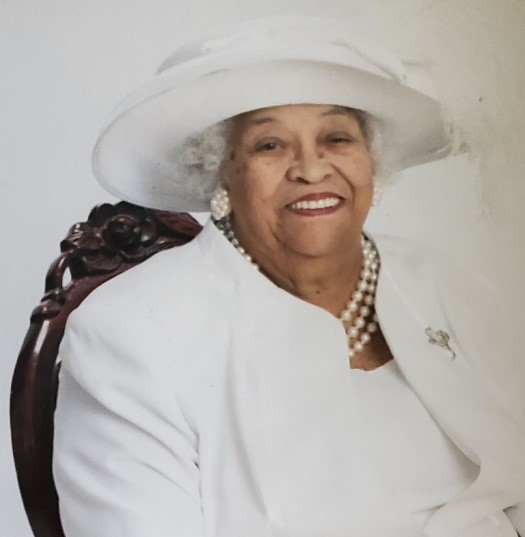
Catherine Elizabeth Ausberry Kilby – October 15, 1918-May 20, 2020
The wife of the late James Wilson Kilby, a prominent African-American figure and leader during the Warren County Civil Rights Movement Era, dies at 101 years of age – in the midst of a pandemic, protests, and marches for equality and justice for Black people.
This African American pioneer woman was born on October 15, 1918, in Flint Hill, Virginia in Rappahannock County to Sarah Jordan and Frank Ausberry, both with roots stemming from slavery.
Her parents were married on March 29, 1902, and never left Rappahannock County where their ancestors were enslaved and there were vestiges of slavery, plantation life, the civil war, emancipation, and Jim Crow before moving into freedom. The reminder of Black subjugation was former brick slave quarters located only a few miles down the Ben Venue Road in Flint Hill, Virginia from the Ausberry farm. Blacks remained in these slave quarters as their homes and then as sharecroppers or tenant farmers working for former wealthy white slave owners until well after the 1870s into the 1900s.
World War I – Before her life began, the United States was in turmoil from World War I, which ended in 1918. During this same time period of World War I was taking place, the Flu Pandemic, known as the Spanish flu, infected around 500 million people, about one-third of the world’s population. The conditions of overcrowding and global troop movement helped the flu spread. The vulnerability of healthy young adults and the lack of vaccines and treatments created a major public health crisis, causing at least fifty million deaths worldwide.
During this time of crisis, racism and prejudice were predominant. Even though the United States experienced a severe shortage of professional nurses in the fall of 1918, the white establishment refused to use trained African American nurses to help combat the crisis created by war and a pandemic so being black, Catherine’s path in life was already charted by her black heritage and the color of her skin.
The 1918 Flu Pandemic – The flu had a large death rate by killing an estimated 195,000 Americans across the country and people were dying at a rate where corpses were stockpiled for burial for more than a week. Cold-storage plants were used as temporary morgues and trolley car packing crates were used as coffins. Public health officials spread the news through education programs about the dangers of coughing and sneezing and disposal of “nasal discharges.” Stores and factories were encouraged to stagger opening and closing hours and people were forced to walk to work instead of using public transport to prevent overcrowding.
Many cities closed theaters, movie houses, and night schools, and public gatherings were prohibited to mitigate the spread of the virus, and persons serving the public had to wear masks along with a strong recommendation made for all residents to wear masks in public. Quarantine signs were placed on the front and rear doors of homes where occupants were infected with the virus.
The pandemic lingered and lasted through December 1920 but Catherine grew in a protected rural environment surviving and thriving through one of the deadliest pandemics in history. The average life expectancy dropped by 12 years. Men only lived an average of 36.6 years and women-only lived 42.2 years. A lot of this was due to the number of lives lost in the war and the number of lives claimed by the 1918 flu pandemic.
Despite all of these national setbacks both Catherine and the United States were flourishing. At the end of 1918, the United States was the world’s wealthiest nation and thousands of immigrants flocked to the nation in the “pursuit of happiness”. Black people in Virginia were still terrorized and compelled to fight their way out of starvation due to joblessness and poverty.
Early Family Life – Catherine, the eighth living child of her parents, was raised with eight other siblings on the family farm and orchards. She grew up working on the farm and had many arduous farm chores inside and outside the house. There was no electricity or running water in the family home. As she grew, she could do everything her brothers could do except more due to the role of the girls and women in cooking, cleaning, washing, and ironing. She rode bareback on the farm horses and drove a horse and buggy.
Growing up close to nature, she hated what she called “devilish snakes” but was not afraid to kill a snake with little armor. The farm had a “spring house” where freshwater from the mountain would settle.
In the summer, after playing or working, she along with her siblings and other farmers would lie on their stomachs and dip the cold water from the “spring house” to quench their thirst.
Catherine’s father purchased or was given milk cows in exchange for services and all the children learned to milk the cows. The milk was stored in bottles or cans in the spring house to stay fresh and cold. Snakes would also come to the bottom of the water in the spring house. Her father was extremely resourceful and was summoned to farms all around Rappahannock to care for animals as a “lay veterinarian”. The family worked the farm and in their orchards, as well as, performed tasks storing or canning food from massive gardens to feed the family through the winter months.


All grades were in the same room with one schoolmaster teacher so her siblings that did not have to work on the farm were in the same classroom with her. Her teacher started noticing her brilliance and talents above the other students, promoted her, and suggested to her father that she was not only a brilliant student in her learning but had a special gift of common sense thinking and hard work, which was significant during this time in Virginia. She was considered a prize.
Catherine boasted of having two dresses. One dress for church and one dress for school, which she washed by hand with homemade lye soap to always be neat and clean. On the other hand me downs were both from her brothers and her sister and the good white folks. She maintained long hair and was always neat and clean and meticulous in her dress, a trait that followed her throughout her life. She only had one pair of good shoes that fit at a time, she wore them to both church and school until the soles were worn out and cardboard was taped at the bottom to cover the holes in the soles until a new pair would arrive from the mail order catalog. She wore boots for her farm chores and walked barefoot inside the home.
Working through many hardships, during her tenure at school, she was named “Miss Rappahannock” by raising money. Hard work was not foreign to her and learning was extremely easy for her so she completed all available educational grade levels that Negroes in the county were allowed to obtain in a segregated prejudice society. Making high marks, she made the best of her education that went to eight years which was considered higher than an eighth-grade education.
The trait of making the best of everything added to her character and reputation. Even though her father never learned to read or write and relied on his children and others to ensure that “no wool was pulled over his eyes”, the farm grew and was enhanced significantly by the Ausberry children’s contributions during the early 1920s; however, economic conditions that led to the Great Depression were creeping into society.
America experienced the highs and lows of life. The struggle for financial growth and survival did not deter the family from acquiring radio and Victrola to play gospel music for shouting and jazz music for dancing creating an atmosphere of weekend gallivanting for the Ausberry boys. After many years of education, Catherine served as her father’s bookkeeper and oversaw some of the farm’s finances and the family business thrived.
Many stories started to emerge about the Ausberry’s family during this period. The guest and frequent visitors were numerous and gravitated to the farm. To keep the boys on the farm to work, Frank not being a devout religious man went into another form of business, the making and selling of corn liquor called “white lightning”.
Prohibition in the United States created a nationwide constitutional ban on the production, importation, transportation, and sale of alcoholic beverages which began in 1920. Prohibitionists attempted to end the trade in alcoholic beverages.
Blacks were not allowed to mingle with white folks in public saloons and bars, but as Frank became known for the quality of his product, both white and black stopped by the farm for purchase. This business was kept secret by the men so Catherine did not know until later in life about the alcohol. Catherine’s mother and her sister and other women were not outdone by the men and made grape and dandelion wine for formal Ausberry dinners, especially for Sunday meals.
Catherine loved the church and was committed to her faith in God and was never a part of all of the frolicking and so-called fun and wild worldly pleasures which was normal behavior for the Negro culture to escape the overwhelming stress of past slavery, racist treatment, and their celebratory rise out of poverty.
Great Depression – The Great Depression began in 1929 when Catherine was only eleven years old and the Wall Street Crash was in her birth month of October, the Ausberry family were undaunted and continued to flourish as Blacks primarily as farmers; however, the family had long arduous days of work and never equal in finances or wealth as neighboring white families that got their status from the backs of African slaves and not from their own hard work.
Even though there were some prosperous Black families like the Ausberry’s, a “well to do” black family was unheard of during this period in Virginia history evidenced by Blacks still living in Free Town.
Built on the backs of slaves, rock walls as fences and slave huts were still remaining after slavery and the civil war. Catherine experienced food rations and the family hid sugar, salt, and flour in tin cans underground not to be seen as being productive or hoarders. The family was self-sufficient and churned their own butter and raised chickens for eggs and animals for meat. Due to a lack of trust and fear of white racism and poverty of other families, the family had to hide everything equated to success or wealth.
Since Catherine’s father was a light-skinned “malatto”, he learned life’s lessons from his white ancestors as well as his African side of his family. He knew his place and listened like a good representation of non-competitiveness or being a threat to whites.
The family did not use the bank to deposit money for most of their farm profits. Money was stored in bags and boxes in the walls of the home for easy access for survival and land purchase. When they had more money than needed to run the farm, it was also stored in tin cans with other assets. This was a way of life that was carried over from slavery into emancipation to avoid becoming tenant farmers.
Like her father, Catherine was fair-skinned, and depending on the environment outside of her world, she could easily wander into the white society with little notice. Her mother was more “African” with darker skin and African features so in Catherine’s Negro world she became more determined to stand up for what she believed was right because she had witnessed first-hand the racism, callousness, and disrespect of whites to Black women.
She knew of women from black-skinned to light-skinned during her time who were treated no better than animals. They were not protected. There were instances of women being violated from lowly workers to wealthy farm owners, having to work in the “big houses or in the fields while carrying their babies, giving birth under trees, and another house woman taking the baby while the mother of the child cleaned up only to be forced to go back in the field to work. The women that were designated to work as men in the fields started trying to disguise themselves as males, tying down their breast, cutting their hair, wearing men’s clothing, primarily overalls, and the wide brim hats to block out the scorching hot sun.
In Catherine’s eyes, these days were unjust and a nightmare period for Negroes, but the pain was multiplied for Negro women. Based on what she had witnessed with screams of agony of women in childbirth however conceived, Catherine vowed not to get married and go through the pain like her mother who had many children, one who child that died as a baby and one stillborn after Catherine was born making eleven births that she was aware of.
In addition, the abuse of other women who were used in such a horrific way as lowly animals made her determined to help others through this painful experience. When the mid-wife came, Catherine knew what was in store for the soon to be a mother. The birthing of babies was only tempered by her living close to the nature of farm life and witnessing the birth of cows, horses, pigs, and other animals and their survival and event of the baby animals for her care.
None the less, Catherine grew up happy because life was not as hard for her family as with some other Black families. Catherine and her siblings were spared some ravishes of racism by working for their own father. She felt valued being an asset to her father and equal to and in some areas surpassing the boys in work on the family farm. Serving as her one of her father’s bookkeepers overseeing the farm finances, she saw the family business thrive.
Early Spiritual Belief – Almost since birth Catherine knew about Macedonia Baptist Church surrounded by the gathering of other Negroes protected by free sacred land. As she matured, she experienced and found God for herself and her spiritual journey began to counteract the drudgery of taking care of a large family, house cleaning, cooking, dishes, and washing clothes by hand and canning and storing food for winter months. Butter was churned and all food prepared. Age was irrelevant but the capability was the identification for chores and at times her frail little body and raw palms were just worn out.
The church was the beautiful part of her escape into her world of relief and joy. She believed that she had an anchor for her life and the women played a major role. The women cooked the food for special church services and homecoming celebrations, visited and cared for the sick. She enjoyed working in Sunday school and participated in many activities and social events as a child and then at the age of thirteen, she was baptized in the Jordan River at Macedonia Baptist Church in 1931.
As Catherine continued to cry out and pray for a better and easier life, she soon yielded and understood her calling from God which was service and caring for His people, and if that had been easy she would not have recognized it as a duty. She realized what that meant and she humbly submitted. She became closer to God when she took care of her ailing mother who suffered a stroke before returning home from a horse and buggy trip to Pittsburgh, Pennsylvania. Her mother lost the use of one of her arms as a residual from the stroke which left her mother somewhat incapacitated.
Even though arduous work was not foreign to her, Catherine and her only sister Mary Jane who was older had additional endless work responsibilities. Mary soon married and started her own family.
Found Purpose from Experiencing Two Life-Saving Acts – While other siblings were socializing, carousing, getting married and some leaving home, Catherine seemed out of place as a humble, serious-minded, quiet, calm, and demur young woman. Catherine, chosen by God, is credited with saving one baby from sure death that was going to be thrown out of a two-story window by the child’s angry father. She stopped him and saved the baby.
The second when Catherine and her father intervened to save a racially-mixed baby that was going to be destroyed in a fireplace from a white family because of being created out of societal boundaries. The child was taken to the Black community to be raised. Catherine was a pied piper, a magnet for children, and babysit for her youngest brother, Edgar, and children born under these same conditions to make sure they were cared for and walked with them miles safely to school to the Freetown Colored School.
World War II – A Second World War broke out by 1939 with the Nazi invasion of Poland, the biggest and deadliest war in history, involving more than 30 countries. While the family was in fear of the boys being recruited to serve in the war, Catherine was totally immersed in church work and her faith.
She admired her Uncle John, a preacher, for serving as a model to show her how to spiritually walk with Jesus. In turn, she ministered to and was successful in getting her own father in church life. Three of her older brothers, Raymond, Carter, and Robert later reported having a calling to preach. Despite the fact that the Jordan family, her mother’s people, and Ausberry, her father’s people, came out of slavery and still associated with Free Town, the family became known as the “pillars of a religious society” in Flint Hill and the Rappahannock County area with a number of preachers who were revered as men of God.


The end of slavery, along with the destruction caused by the war, led to the break-up of many of the largest Virginia plantations and his family was unable to become progressive.
Catherine was fascinated by James with his ideas and wit. His life had been so different from her experiences. He talked about being a sharecropper, a system under which both landowner and tenant received a share of the crop. Landowners advanced sharecroppers seed, fertilizer, and provisions in exchange for labor. Sharecroppers planted and tended the crops and cared for livestock.
With a history as former slaves before emancipation, the Kilby family whose name came from the previous slave owner, benefited because they received food and shelter. However, James told Catherine, he was still poor and his family struggled for survival because his father was still subjugated and wedded to his white slave owner’s descendants and connected with them as trustworthy friends. He vowed to Catherine he was going to rise above all of that.
James was well-respected, worked in Nazareth Baptist Church, which he was best friends with the Pastor. He had a reputation for leadership and recognized as an independent thinker. He not only worked in the church but did jobs like trapping and skinning animals for sale and covering straw bottom chairs outside of the farm to buy a car. Driving became his passion and he used it as a source of income driving those who could pay for driving.
When James came into Catherine’s acquaintance, he was driving school teachers to PTA meetings. During this time, prohibition had already ended in 1933 and it was the worst economic crisis in the history of the United States with the Great Depression, but Catherine fell in love with her relentless suitor, James Wilson Kilby. After a somewhat lengthy courtship, Catherine and James got married on April 19, 1941. On the day of their marriage, James dug potatoes all morning and headed off from Madison County to Flint Hill to pick up Catherine to get married. Together James and Catherine with Mary Jane, her sister as a witness traveled to the home of Reverend Thomas L. Proctor, Pastor of Macedonia, in Front Royal, Virginia.
James did not wear a suit but Catherine looking like a young petite child wore one of her only two dresses sized for thirteen years old and her prized pair of shoes. Nannie Proctor, the pastor’s wife, played a song and Reverend Proctor married them. James gave Catherine a simple plain 14-caret gold band. They became husband and wife. Catherine stated calling him “Wilson” because James was such a common name and he was special.
In love, James moved Catherine to Madison County but she realized that living his life of a poor destitute wife was more difficult and worse than the hard work growing up on the Ausberry farm as independent freed people. The owners of the land, along with Wilson’s father convinced Wilson and Catherine to stay on the farm and as payment, they would be given property with an old house and pounds of flour and sugar, as well as, a fat backside of pork. James and Catherine agreed to stay and work. (1) “The Kilby Legacy: I Stretch my Hands to Thee”
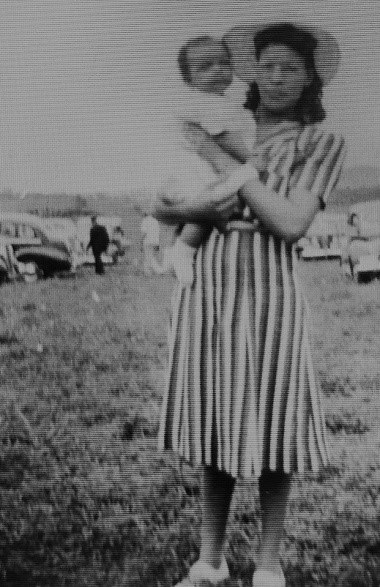

Catherine and child
Fleeing from Poverty – Catherine counted the days and after the agreed-upon time the contract for sharecropping ended, James asked for his deed to his earned property, but James was denied the property. Time was added so James had to continue to work off additional time and Catherine became pregnant and their first child born in April 1942, second in 1943, and by 1945, a third child was born.
Life had blessings with her new family, but it was hard and in reality, the sharecropping system worked to benefit the landowner. James was cheated out of wages and battles were in the landowner’s favor; therefore, the accumulation of debt and poverty made his control over his family as a sharecropper meaningless.
Catherine and James sought refuge with the Ausberry family and Frank became Wilson’s role model. Catherine’s mother died much younger, twenty to twenty-five years before her husband Frank, who did not pass away until February of 1965.
New Beginnings in Happy Creek, Virginia – James Wilson and Catherine created a strong family unit. As circumstances changed with the influence of Catherine’s father and brothers, changes in farming, and demanding needs of the family, James Wilson Kilby started to rise as his own man and meet his fullest potential as he had promised. Catherine’s bond and deep love for her husband grew so she elevated him and enduringly called him “Kilby”.
Along with Catherine’s brothers, Kilby obtained a factory job at the American Viscose Corporation (Avtex) in Front Royal for a better quality of life for the family. After working at the American Viscose, he moved his family to Happy Creek, Virginia, a Black settlement, three miles from his job in Front Royal, Virginia.
By 1948, Kilby joined with two other Black men who purchased one hundred acres of land and divided it for farming in Happy Creek. They built their first house and the fourth child was born.
The farm grew with cows, pigs, chickens, ducks, vegetable gardens, and fruit trees. Barns and silos were built for corn and hay to feed the animals. Together with her husband, they created a dairy farm. The milk from the cows became a valuable Kilby family business commodity, adding to the richness and culture of Blacks in the community. At times Catherine worked side by side with her husband to complete farm work and other times raised her children preparing three meals a day, including meals for the farmworkers. She handled the finances for the farm.


The Kilby Family
Catherine’s fifth and last child was born in 1951. They were raising three sons and two girls.
The Building of Hope and Faith – Despite all of the hardships and handicapped by racism and prejudice, Catherine grew as a strong Black woman. Shortly after marriage, Kilby had become a Deacon and Catherine a Deaconess at the Macedonia Baptist Church in Flint Hill.
In this spiritual role, Deacon James Wilson and Deaconess Catherine Kilby became the strongest supporters and decision-makers within the church. They joined with other church members to create a viable and resolute African-American church to improve the Rappahannock and Warren County Black communities. They raised the children in a God-fearing home.
Catherine participated in every facet of church life from singing in the choir to organizing various helping-hand clubs, ways and means, and auxiliaries, and serving as assistant church clerk to maintain accurate church records. She helped the church to accomplish many goals, supported church improvements, and was relentless in her dedication in service to God, his people, and church work.
The Kilby family also participated in and supported the two Black churches located in Happy Creek, Mount Nebo Baptist Church, and Saint Paul Primitive Baptist Church. The family children enhanced the culture of the community by leading and teaching Sunday school, writing plays, and coordinating holiday programs. They patronized the other Black businesses that were developed within the community and particularly supported the 4-H Club. The 4-H Club became the “community socialization hub” and united the Black men and families together for a stronger community.
Catherine was not the only mother to her five children but she opened her home to other extended family members and some stayed short-term and others stayed long-term to go to school. She cooked three meals each day and was noted for her famous elegant cooking and baking.
On holidays all of the family and extended family members would gather at the family home to create family memories.
The Fight for Equality and Civil Rights – Catherine was a strong wife and mother dedicated to raising and providing a good education for her children. As such, to stem the fear of the ravishes based on stories about the Ku Klux Klan (KKK), she and her husband supported and worked with the National Association for the Advancement of Colored People (NAACP) in Warren County and the Parent Teacher’s Association (PTA) at the Front Royal Colored School during a very tumultuous time in our history. She became a life member of the NAACP.
Integration Movement – By the 1950s, Kilby had become a well-known activist and leader of the Blacks in Warren County while serving as President of the NAACP and later the NAACP Education Committee chair. Catherine had learned lessons from her father about how to protect the family so she was a reluctant participant in waging a “war on society”.
However, she was her husband’s greatest supporter and was determined to fight for his causes. She stood by his side to bring about equality, justice, and change, primarily in the areas of education and job opportunities for people of color.
During the Warren County court cases to integrate Warren County High School, she opened her home, entertained and cooked meals for Civil Rights leaders and NAACP lawyers and served meals at her kitchen table in her home. She stood firm with other Happy Creek and Warren County mothers and families in the desegregation of the schools (1958-59). She participated in sit-ins to eat at lunch counters, as well as picketed businesses and marched for equal employment opportunities.
During one of the court appearances to integrate the schools in Warren County, which she attended with her husband, she believed the antagonists were abusing and treating her children unfairly, she became distraught and raised and started swinging an umbrella she held in her hand to show her retribution against the racist perpetrators. Her husband and the attorneys had to hold her back as she proclaimed “no one was going to hurt my children”.
Along with the other families, her family was attacked and suffered many hardships and setbacks.
Catherine witnessed the destruction of her world as she knew it. The attacks on her husband, continuous telephone threats, killing of farm animals, pets, and watchdogs, shooting at the house, bloody sheet on the mailbox, lynching noose on her porch, and crosses burned in her yard and loss of jobs and wages.
Due to retaliation from being a part of the civil rights movement to integrate Warren County High School, citizenry actions to destroy the Kilby livelihood rendered the farm no longer profitable and it basically in time become insolvent. Not defeated and in an effort to support her family, she personally took on the battle to recover.
Supporters in Virginia and around the country as the news spread came to know Warren County since Warren County’s hard-fought legal case for equal education resulted in the closure of the first high school to be closed to test Virginia’s “massive resistance” laws so her greatest loss was to allow her children to live in Washington, D.C. to be educated until the courts reopened the school.
The consequences in the fight for equal education were severe and impacted many fronts in life. This caused Catherine’s great grief and changed the dynamics within her family only leaving her two youngest children home until Warren County High School opened to the Black students and her other children returned home. (1)”The Kilby Legacy: I Stretch my Hands to Thee”
During the darkest and most desperate times in the family, Catherine rose up as a resourceful determined role model and entrepreneur. She left her two youngest children to travel seventy to seventy-five miles one-way, collectively more than a hundred miles a day in the dark of morning to clean houses for survival pay while collecting used clothes for her children to wear and food products to bring home to generate family income to counteract total devastation. She worked for this survival and family rebuilding for nearly fifteen years.
Black Woman-Owned Business – From the sixties to the seventies, Catherine while seeking equality blossomed and reached her peak as a dynamic businesswoman capitalizing on her financial skills from her experience during the depression.
Forced to work on behalf of her family and a generous desire to also uplift other families, she became consumed with an entrepreneurial spirit. She had never gotten a driver’s license and could not drive, but she used her savings from working to purchase a nine-passenger station wagon, hired a driver, and organized a riding force to travel to the Washington metropolitan area to work.
This became so lucrative, she added a second vehicle to her business and employed a second driver and expanded the employment opportunities for others to bring money and resources back to Happy Creek and the Front Royal community.
Civil Rights: Education, Protests, Marches, and Sit-ins – Catherine and her husband not only marched and participated in sit-ins in Warren County, but Catherine followed Martin Luther King and participated in the March on Washington in Washington, DC in 1963.
After the marches and sit-ins for equal employment opportunities, a racial trailblazer and barrier breaker, Catherine became the first African American woman to become employed at McCrory’s retail store in Front Royal, Virginia.
It became evident to Blacks who were fearful about upsetting white folks that boycotts and picketing for equal employment opportunities were ultimately worthwhile for future generations. She worked for ten years until she retired after all five of her children had completed school or college.
Family Education – All five of their children received a high school diploma from Warren County High School, the high school Kilby fought to integrate and get an equal education for his children. Catherine wanted the best education for her children.
Her second son, John, was exceptionally bright, tested high on his SAT and was accepted at Fisk University. Her youngest daughter, Patricia, was also a high achiever and was accepted at colleges in Virginia; however, Catherine had become acquainted with Howard University during the civil rights movement and the integration cases with Thurgood Marshall, Spotswood Robinson, and Oliver W. Hill so when her youngest daughter expressed an interest in attending Howard University, she took her to Washington, DC for a meeting at Howard.
Even though her daughter had not previously been notified of her acceptance, during the meeting, Catherine asked the Howard registrar to discuss her application and before the meeting ended her daughter was not only accepted but registered.
Catherine did not like city life and since she felt responsible for her daughter’s matriculation at Howard, she formed a close bond and called her daughter every day for a progress report. She would prepare care packages with her famous applesauce cake for her daughter’s roommates and best friends. Catherine not only forged a close bond with her own daughter but her roommates as well.
Her youngest son also attended the same university.
Catherine’s Diploma – Catherine and her husband believed it was never too late to get an education and they attended night school to get a GED. They were awarded their Warren County High School diplomas in 1991.
Volunteer Involvement and Voting Rights – While employed, she had a membership with senior citizen organizations such as AARP, which she served as treasurer. She volunteered with the Warren Memorial Hospital Organization.
Early on in Catherine’s life, she heard her family talk about Negroes did not have the right to vote. This denial was instilled in her that Negroes could not vote so she wanted to change that for her children so Catherine supported voting rights. She believed in exercising citizens’ rights, campaigned for elected officials, and worked on the voting polls. Catherine lived through eighteen presidential administrations from President Wilson to Trump. She cited Presidents Kennedy, Carter, and Clinton as favorites; however, her greatest excitement and joy came with the election of President Barack Obama, the first African-American President, who she called “her President”.


100 Year Museum Portrait
Catherine’s Inspirational Life and Legacy – Catherine’s legacy is quite extensive. Her marriage to James Wilson Kilby spanned sixty-two years until his passing on May 2, 2003.
She has led four generations of the Kilby family lineage: including five children, James, John, Betty, Patricia, and Gene; twelve grandchildren; twenty-seven great-grandchildren; six great-great-grandchildren.
As the only living Ausberry sibling, she became the valiant matriarch of the Ausberry family and the surrogate mother to generations of the Ausberry relatives.
Historical Contributions – Together with fortitude and tenacity, Catherine and her husband made significant historical contributions that impacted the life and culture of Virginia. They forged an extensive legacy during that civil rights period of time in changing the course of education with the integration of Warren County High School, teacher recruitment, sit-ins and protests for equal employment opportunities, programs in housing from construction to weatherization projects in housing.
As Catherine and her husband grew older, they experienced life by traveling all over numerous states up and down east and west coasts of the country meeting with NAACP representatives. They also traveled to Mexico, Canada and in the Caribbean with family members.
With the loss of her husband, Catherine kept the faith, continued the family legacy, and preserved in changing history for seventeen more years. Her life slowed and changed, but she did not give up her beliefs and kept building her own legacy.
Before the passing of her husband who was not only a civil rights leader but also a visionary and supporter of fair and equal housing for all, especially poor people of color, he assisted families with weatherization projects, building and purchasing newly constructed housing. She continued to be instrumental in carrying out his legacy and vision to create a housing subdivision on the land that they had acquired early in life in Happy Creek, Virginia. Currently, the Kilby vision and legacy was envisioned by “Village Court”.


Mother of Macedonia Baptist Church- oldest and longest standing member of the Macedonia Baptist Church with membership for eighty-eight (88) years, serving as a Deaconess for more than seventy-seven (77) years
Catherine Elizabeth Ausberry Kilby, a woman of distinction within the community is celebrated and held in the highest esteem with a remarkable and inspirational life touching many lives based on her role to bring about change and enlightenment for the people of Virginia. Her reputation and character as a stately, classy, impeccably dressed lady was ever-present as a role model and teacher for the younger African American women in the church and community.
A woman blessed with many hats was her trade-mark; she exquisitely matched them with every outfit and wore them proudly as a crown of the witness for her love, dedication, and trust for the God she served.
Over the years in her role as Deaconess, she reached out in compassion for others in feeding the hungry, visiting the sick, encouraging the hopeless, and providing guidance, while holding her family and friends close to her. Catherine was full of love that she not only loved her family but also everyone she met.
Leaving a Trail for the Next Generation – For her last accomplishment, her late husband had left his vision and financial means for her to take care of herself so she continued to fulfill her husband’s desire to create the “James Wilson and Catherine Kilby African-American Historical Museum” in Happy Creek, Virginia, which she witnessed the restoration of the structure and the beginning of the artifact collection in 2019 as a work in progress.
History Repeats Itself: End of Life’s Journey during COVID-19 Pandemic, Protests, and Marches for Equal Rights and Justice – Catherine lived surviving through a period of the Flu Pandemic in 2018 at the beginning of her life and endured and now with the emergence of the coronavirus-COVID-19 worldwide pandemic at the end of her life.
The same as in 1918, the pandemic virus has had a large death rate by killing millions of people around the world. People dying at a rate where corpses were stockpiled for burial for weeks. Cold-storage plants and skating rinks were used as temporary morgues and wooden crates for use as coffins for mass burials. Public health officials spreading the news through the media about the dangers of coughing and sneezing and disposal of “nasal discharges.” Stores and factories are encouraged to stagger opening and closing hours and people are forced to walk to work instead of using public transport to prevent overcrowding. Many cities closed theaters, movie houses, and night schools, and public gatherings are prohibited to mitigate the spread of the virus and persons serving the public are wearing masks a strong recommendation was made for all residents to wearing masks in public.
Quarantine signs are placed on the front and rear doors of nursing homes where occupants are infected with the virus. There is an acute awareness of inequality and injustice for Black people creating political unrest and chaos. Protesters are marching in the streets around the world to protest this injustice, racial inequality, and the killing of young Black people. The country has high unemployment rates and people have lost jobs and there are food shortages and lines and stimulus checks for financial survival.
As a pioneer, Catherine left a road map for us to follow. Her story and legacy are so relevant and meaningful because she completed life’s journey to lead the way for the next generation to emulate how to bring about change-Catherine experienced it all, fought, and thrived from 1918-2020 and has left the world a better place than when she inherited it. Even though Catherine’s cause of death is still unknown, she continued to serve God until the end.


During Catherine’s pandemic burial at the James Wilson and Catherine Kilby grave site in the Panarama Gardens Cemetary, Patrica Kilby-Robb is holding the “Together Forever” picture honoring the life and legacy of her parents. (May 29, 2020)
A Memorial Service will be held later this year.
Patricia Kilby-Robb (Daughter): Excerpts from recollections, “The Catherine Elizabeth Ausberry Kilby Story”.
1. The James Wilson Kilby Story is in the book entitled, “The Kilby Legacy: I Stretch my Hands to Thee”, written by James Wilson Kilby and Patricia Kilby-Robb, 2000. His history is a part of the archives in the “James Wilson and Catherine Kilby African-American Historical Museum” located in Happy Creek, Virginia.
2. The Catherine Elizabeth Ausberry Kilby Story and historical chronicles from her “Life and Legacy” will become a part of the archives in the “James Wilson and Catherine Kilby African-American Historical Museum” located in Happy Creek, Virginia.
3. Photographs by Deacon Mike Coward, Macedonia Baptist Church. The stories and pictures are the property of the James and Catherine African-American Historical Museum and permission must be requested for reprinting for publication use.


The Kilby-Robb Generation
Four generations: First generation-far bottom right Catherine Ausberry Kilby (matriarch); Second generation- standing behind her mother, Patricia Kilby-Robb (Daughter) and husband Nathaniel Robb, third row center; Third generation-Dawnielle Kilby-Robb (Granddaughter), second row center; Earl Franklin Robb (Grandson), right side third row; Fourth generation- Delaunte Allen (Great-grandson), left side third row; Dayanna Kilby-Robb (Great granddaughter, left side first row; and Adrianna Nunn (Great-grand daughter standing on front row.
Chamber News
Melodies on Main: Community Cheers as Money Pit Recording Studio Opens Doors
Local News
Blue Ridge Wildlife Center Patient of the Week: American Toad
Please remember to check your lawn before you mow!


Patient 24-683 recovering at BRWC. @BRWC 2024
This beautiful American toad was hit by a lawnmower on Saturday and suffered injuries to the right wrist and right hind leg.


Patient 24-683 at intake.
Unfortunately, due to the level of trauma, the right hind leg required amputation at the level of the knee, which was performed once the patient was stabilized.
This patient is still eligible for release once recovered and will do just fine in the wild, even with one less leg to hop on!
This time of year we see species of all kinds come into care with injuries inflicted by mowers and weedwhackers. Luckily, injuries like this are preventable in many cases.


Patient 24-683 recovering at BRWC. @BRWC 2024
Some people will sweep their lawn with a broom to flush out any animals that may be hiding (also a great way to find and protect a bunny nest). You can also enlist a child, partner, or friend to keep you company while you mow by walking a few feet ahead and checking for wildlife as they go!
Or, if you are looking for an alternative to a turf grass lawn, consider replacing some or all of it with native plants! Traditional lawns provide little functional space for wildlife, use excessive water, and often introduce fertilizers and pesticides that damage our environment.
Reducing the need to mow and creating beautiful and healthy habitat for native wildlife is a win-win!


Native pollinator garden at BRWC. @BRWC 2022-2023
Looking for an easy way to help native wildlife? Become a monthly BRWC donor! For as little as $5/month, you can provide year-round, sustainable support that helps us fulfill our mission.
Local News
Warren County Virginia Sheriff’s Office Rallies Support for Deputy Whose Home Was Severely Damaged by a Fire
In an urgent Facebook post on Monday, April 22, Sheriff Crystal Cline alerted the community to the plight of a deputy whose home was severely damaged by a fire that day.
“This morning, we were reminded of the unpredictable challenges that life can throw at us,” she wrote. “One of my deputies faced a heartbreaking tragedy when a fire severely damaged his home, resulting in the loss of everything he held dear, including his beloved pet.
“This deputy has lived his life on the frontlines—he served in the Army, then as a volunteer and professional firefighter, and now as a deputy with the Warren County Sheriff’s Office serving our community.
“Your support, whether through prayer, donations, or financial contributions, will help provide the immediate needs of shelter, clothing, and other essentials during this critical time. The Warren County Sheriff’s Office (200 Skyline Vista Drive, Front Royal, VA) will be a drop-off location for any physical items or financial donations—ask for Jenn.
I appreciate your kindness, generosity, and support. We are more than a community; we are a FAMILY!”
Out of respect for the deputy, his identity was not revealed. Even so, the sheriff’s Facebook page has been inundated by people who want to help. Many types of donations are welcome, as the sheriff emphasized, and for those specifically wanting to make online financial contributions, a link is provided on the WCSO’s page. Michael Glavis of the WCSO has organized that site for raising funds, the “Sheriff Deputy House Fire Relief Fund.” Glavis considers the deputy a dear friend and work colleague. “He has given blood and sweat for others, and now I’m asking for everyone to give a little to help him and his family through the process of recovery,” Glavis said.
Local News
Illuminating Futures: Celebrating Achievements and Exploring Quantum Computing at ‘This is IT!’ Event
The “This Is IT!” club of Warren County, Virginia, marked another milestone as a hub for budding IT enthusiasts from diverse backgrounds. The club, which started in 2023, has quickly become a cornerstone for students interested in the ever-evolving world of information technology.
At the ‘This is IT!’ club gathering at the Samuels Public Library on Wednesday, April 17, 2024, students and community members came together to celebrate and learn. The club includes 9th to 12th-grade students from public, private, and homeschool backgrounds and is aimed to ignite curiosity and reward academic excellence in information technology and quantum computing.
The ceremony kicked off with an introduction by Melissa Chapman, an instructor involved with the club. She set the stage for a night that was not only about recognition but also about expanding young minds. “Understanding the vocabulary of quantum computing is the first step towards mastery,” Chapman remarked, highlighting the importance of foundational knowledge in this cutting-edge field.
The focal point of the evening was the guest lecture by Dr. Bruce Chesley, an aerospace engineer who adeptly connected the seemingly distant realms of space exploration and quantum computing. With palpable enthusiasm, Dr. Chesley described how quantum technologies could revolutionize our approach to exploring the cosmos. His talk made the complex topics accessible and entertaining, captivating the aspiring scientists in attendance.
Amidst the talks, the club took a moment to honor its bright young members through a scholarship awards ceremony. Scholarships were awarded to students who have shown exceptional prowess in STEM fields. These awards are a testament to the community’s support for its young learners and a major encouragement for them to pursue further education in technology. The winners were Jude O’Neal, Elijah Hambric, Jack Gillespie, Benedict Keough, Matthias Biedler, and Uli Duke.
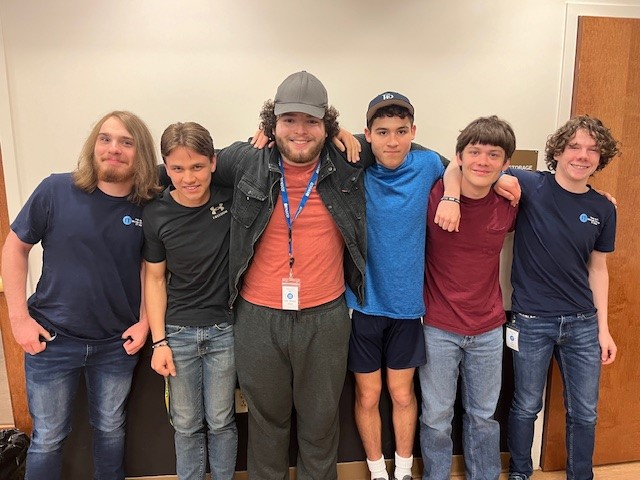

From left to right: Jude O’Neal, Elijah Hambric, Jack Gillespie, Benedict Keough, Matthias Biedler, Uli Duke
Local News
The Apple Blossom Coronation Legacy Continues for the Historical Event
For the first time in the history of the Shenandoah Apple Bossom Festival® three consecutive generations in a family will have served as Queen Shenandoah. Susan Ford Bales, Queen in 1975, and Tyne Vance Berlanga, Queen in 2001, will be accompanying Joy Elizabeth Berlanga as she assumes her role as Queen Shenandoah XCVII.


The Crowning Ceremony entertains from regal pomp and circumstance to joyful enthusiasm of Little Maids and Pages who are ever present to serve their Queen. The youthful court interchange historical and educational facts from the British Crown to learning about a United States President – to asking, “Who has the Crown?,” and with dancing. The Queen will be crowned at the memorable Coronation celebration under the direction of Elaine B. Aikens. The Ceremony to install the new sovereign is sponsored by Morgan Orthodontics, on Friday, May 3 at 1:30 p.m.at Handley High School. President Gerald Ford crowned Susan. Susan crowned Tyne, and Joy will be crowned by her mother and escorted by her grandmother.
Susan, Joy’s grandmother, is a Virginia native and now resides in Texas. She is the daughter of President Gerald R. Ford and Betty Ford. Susan is the mother of two daughters, Tyne Berlanga and Heather Deavers, five grandchildren, Joy Elizabeth Berlanga, Cruz Vance Berlanga, Elizabeth Blanch Deavers, Jude Deavers, and Sullivan Bales, and three stepsons, Kevin, Matthew, and Andrew Bales.
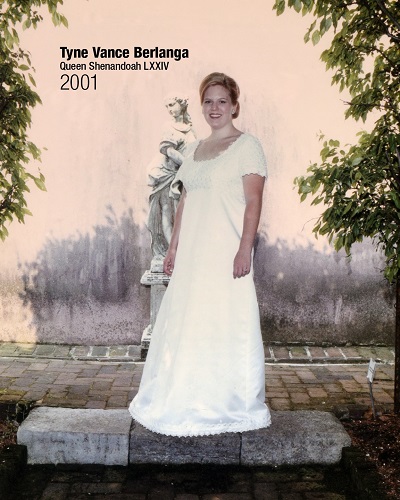

Susan was raised in Alexandria, Virginia and attended Holton Arms School and the University of Kansas, where she studied photojournalism. She is the recipient of an Honorary Doctorate of Public Service degree, an Honorary Doctorate of Letters degree, and an Honorary Doctorate of Humane Letters degree. She is the author of two novels set in the Whie House, “Double Exposure: A First Daughter Mystery”, and its sequel, “Sharp Focus.”
Susan is the Ship’s Sponsor for the aircraft carrier USS Gerald R. Ford (CVN-78), which she officially christened on November 9, 2013. On April 8, 2016, in recognition of her service as the Ship’s Sponsor, she was named an Honorary Naval Aviator by the United States Navy, becoming only the 31st American to receive this distinction. And history was made with her selection – Susan is the first woman to be chosen as an Honorary Naval Aviator.
During her high school years, Susan lived in the White House and served as official White House hostess following her mother’s surgery for breast cancer in 1974. In 1984, she and her mother helped launch National Breast Cancer Awareness Month, and Susan subsequently served as national spokesperson for breast cancer awareness. Since the founding of the Betty Ford Center in 1982, Susan worked side by side with her mother on projects at the Center and was elected to the Center’s Board of Directors in 1992. She succeeded her mother as Chairman of the Board 2005-2010, and currently serves on the board of directors of Hazelden Betty Ford Foundation.


In addition to her many charitable public service activities, Susan serves as Co-Trustee of the President Gerald R. Ford Historical Legacy, Trustee, Trustee of the Elizabeth B. Ford Charitable Trust, and the Honorary Advisory Committee of the Children’s National Medical Center.
Tyne, mother of Joy, Queen-designate, resides in Frisco, TX with her husband Hector and two children, Joy and Cruz. She serves as a marketing manager for Western Son. With a passion for community involvement, Tyne sits on multiple school booster club boards for all her children’s activities.
On Tyne’s departure as Queen she reflected, “It was easy to be kind, gracious and humble Queen when surrounded by the people of Winchester. My five-day reign as Queen Shenandoah was an occasion that will have a special place in my heart. I have formed friendships and made memories that will hopefully stay with me for a long time to come. On Sunday morning I was doing an exit interview with one of the reporters and he asked me, “If l had a daughter would I let her be Queen?” My answer was immediately “Yes, if she’s lucky enough to be given this opportunity.” Now, Tyne eagerly anticipates returning to Winchester where Joy is set to embark on a remarkable journey, echoing Tyne’s own experiences from 23 years prior. It’s truly heartwarming to be able to share this moment with both her mother and daughter.
The Queen and her family will ride in the Hang 10 Firefighters’ Parade Friday evening at 5:30 and the glo fiber Grand Feature Parade on Saturday, May 4 at 1:30 p.m. Queen-designate Joy and her family will be making appearances at Festival events during the weekend.
Tickets to Festival events are available at www.thebloom.com/events.
Community Events
Valley Chorale Announces Upcoming Spring Concerts in Middletown and Front Royal
The Valley Chorale presents “Wishing On a Song – Music in the Key of Hope”, a spring concert exploring aspirations of love, home, spirituality and compassion that unite and uplift us all. With styles ranging from light classical and sacred to vocal jazz, spirituals and pop, The Valley Chorale strives to capture the hopes that unite us.
The Valley Chorale is known throughout the Shenandoah Valley for innovation and excellence, with piano, cello and percussion accompaniment, and their concerts are often a heart-warming experience for all. They welcome babies and tots, so no need to hire a babysitter.
Tickets can be purchased on their website TheValleyChorale.org — $15 for age 21+ (free under age 21) or at the door for $17.
SATURDAY, MAY 4, 3:00 – 4:15 PM
Belle Grove Plantation (Bank Barn), 336 Belle Grove Road, Middletown, VA
SUNDAY, MAY 5, 3:00 – 4:15 PM
First Baptist Church, 14 W. 1st Street, Front Royal, VA (Community Reception to follow)
For further information, visit the website: TheValleyChorale.org: follow them on Facebook; email them at TheValleyChorale@gmail.com or call at 540-635-4842.
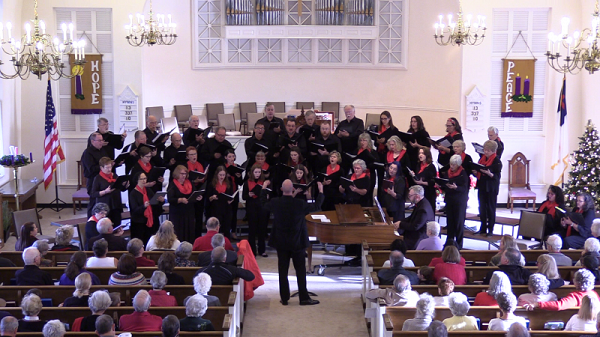

Courtesy Royal Examiner File Photo of The Valley Chorale during the Christmas season. Get ready for their spring concerts ‘Wishing On a Song – Music in the Key of Hope’ the first week of May.
(From a Release by The Valley Chorale)




















































